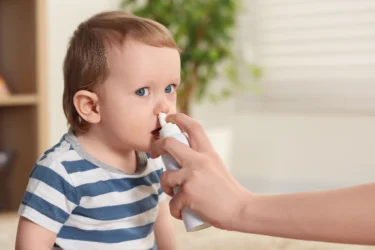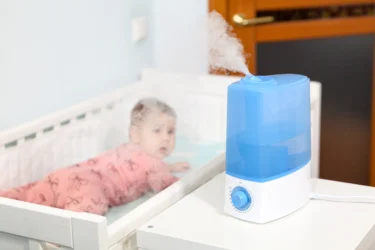Caring for a Baby with Blocked Nose: Simple Tips for Parents
By Dr. Anmol Batra +2 more

Get,

to manage your symptom
Get your,


4 Cr+ families
benefitted

OTP sent to 9988776655



You’ve successfully subscribed to receive
doctor-approved tips on
Whatsapp

Get ready to feel your best.

Hi There,
Download the PharmEasy App now!!


Register to Avail the Offer
Send OTPBy continuing, you agree with our Privacy Policy and Terms and Conditions

Hi There,
Sign up on PharmEasy now!!
Trusted by 4 crore+ families

OTP sent to 9988776655



You have unlocked 25% off on medicines




Code: NU25
By Dr. Anmol Batra +2 more
Table of Contents
Blocked nose is when there is difficulty in breathing through the nose. It can happen due to an obstruction in the nasal passage or more commonly due to swelling in the lining of the nose (occurring due to several reasons).
Blocked nose can be very distressing as it can interfere with breathing. In babies, it can further lead to sleep disturbance, irritation and poor feeding1. Sadly, as the little ones cannot even express what they are going through, they just tend to cry, become irritated or even miserable at times. Moreover, when it comes to babies, blocked nose can be difficult to manage as only very few medications can be prescribed by doctors to these young ones.

Well, following some simple measures at home can help you ease your little one’s discomfort, but it is also important to know when to take medical advice.
In this blog, we will discuss about the signs of a blocked nose in babies, share certain tips that can help avoid your baby from getting a stuffy nose, some simple measures you can take at home to ease their symptoms and when you must check with a doctor. So, let’s get started!
Common causes of blocked nose can include some external and internal factors. These are1,2:
External factors lead to nasal congestion, commonly known as a stuffy nose, by irritating the membrane of nasal mucosa. In response to this, the nasal lining swells and increases its mucus production, leading to the sensation of a blocked or congested airway. The excessive mucus may sometimes start oozing out of the nose causing a runny nose2.
A blocked nose can present with a variety of symptoms, including7,8.
While nasal congestion symptoms in babies can vary from one to the other, it’s important for parents to keep a close eye on all the signs, no matter how minor they seem.
Dealing with a stuffy baby nose is never easy, but you can help them feel better with these simple, natural methods you can use right at home2,9,10.

A saline nasal wash is beneficial for cleansing and moisturizing nasal passages. It works by flushing out irritants like pollen, dust and other debris. This will also help to remove extra mucus in the nasal cavity. Normal saline drops or spray are available in all pharmacy stores. Some nasal washing devices like neti pots, rubber nasal bulb are also available at the stores11,18.

For this, firstly moisten the nasal cavity with a saline spray and squeeze the bulb of suction to expel the air. Then gently insert its tip into the nose and release the bulb to suction out the mucus. If the mucus is properly moistened it will be easily expelled using the bulb. Make sure to do this before feeding because a clearer airway will help the baby feel better, leading to more successful feeds12.

This helps to moisten the air and clear the nasal cavity. Place the unit 2 meter away from the bed. Avoid running the vaporizer continuously and keep humidity between 40% to 50% to prevent mould and mildew (type of fungus) growth because it can cause breathing issue. Use distilled water instead of tap water, minerals in the tap water can cause harmful white dust and breathing problems. Make sure to clean and dry the vaporizer before and after each use to prevent from bacterial infection13.

Giving direct steam for babies is not safe as it can cause burn so, create a steamy environment by running a hot shower and sitting with your baby in the bathroom for some time before bed.

Make sure your baby stays well-hydrated. Continue breastfeeding or formula feeding and if you feel child is struggling to eat try offering smaller amounts more frequently. Giving them plenty of warm fluids helps thin out mucus and prevents dehydration.

To reduce nasal congestion and to help your child breathe easier, you can raise the head of their bed. Try placing a pillow under the head of the mattress or putting some blocks under the bed’s legs at the head.

To reduce their fussiness and irritation it’s important to have a good sleep and rest. Following the above steps should help the baby feel better to a certain extent and promote proper sleep and rest.
When your baby has a stuffy nose, these simple, natural tricks can make some difference. By helping them breathe easier, they will be more comfortable and will be able to get the rest they need to feel better.
Note: You must not rely only on these home remedies for the treatment of the condition.
Finding out how to treat congestion depends on what is causing it. Your baby’s doctor can help you find out what is going on and suggest the best ways to help your little one feel better.
Preventing frequent nose blocks in babies is often a matter of taking a few simple, proactive steps. By focusing on some points mentioned below, you can help your little one breathe easier and stay more comfortable14,15,16.
Taking these few simple precautions, you can make a big difference in preventing frequent nose blocks in your baby. By focusing on good hygiene and creating a healthy environment, you can help them stay healthy.
It’s natural to worry when your baby is sick. Knowing when to call a doctor or seek emergency care can make a big difference. You should call your primary care provider if they have any of the following symptoms15,16,18 :
Seek emergency care if you see below symptoms:
Knowing these important signs gives you an idea of what action to take. Like when to call a doctor for a persistent problem and when to rush to the emergency room for breathing trouble. This will ensure your little one gets exactly the right care when they need it.
A stuffy nose can be tough on the little one but remember that it’s a very common hurdle for parents. The good news is that, by staying calm and trying some simple, gentle home remedies, you can help your baby feel a lot more comfortable. Look out for signs that need medical attention, and if you have any concerns or questions, remember that your doctor is always there to provide guidance and reassurance. With a little care and patience, your baby will be breathing easy and be back to their cheerful self in no time.
Using a suction bulb and normal saline drops is the better way to reduce nasal congestion. If mucus is too thick and dry, moisten the nasal cavity first and then use suction bulb to remove out the mucus2.
There are many over the counter (OTC) medicine available in pharmacy for blocked nose and cold, but doctors do not recommend any medicine before the age of 2 years. If in case of any emergency, it’s always better to consult doctor before giving any medicines19.
Sleeping on their back (supine position) with slightly elevated head will help to drain out the mucus from nose. This can be done either by placing pillow below the mattress or by lifting head end of the cot with the help of blocks. Please note: Do not place any pillow or stuffed toys on their crib or bed; this can increase the chance of suffocation during sleep time2,19.
Yes, blocked nose can affect a child’s oxygen levels. Since babies mostly breathe through their noses for the first few months, a blocked nose can make it hard for them to get enough oxygen. When that happens, their body has to work much harder to breathe, a condition called respiratory distress. If you observe symptoms like bluish discoloration, decreased urine output, nasal flaring, rapid or shallow breathing and unusual chest movements, seek immediate medical attention20,21.
Some people believe that applying Vicks to a baby’s chest, neck, back, and the soles of their feet can help with congestion. However, since babies are sensitive, you should always check with your doctor before using any topical medicine.
As per the Chinese medicine trial, giving circular pressure in LI-20 and LI-4 will help to breathe easier
LI-20: It is located at the base of the nose, both side near the wing of nostrils.
Use index finger and give slight pressure bilaterally for 4 minutes.
LI-4: It is located between the thumb and index finger
Compress for 2 minutes on both right and left hand22.
It’s a common practice for many parents to rub Vicks on their baby’s feet. However, it is always safest and best to check with your paediatrician before using any topical product on your child.
Disclaimer: The information provided here is for educational/awareness purposes only and is not intended to be a substitute for medical treatment by a healthcare professional and should not be relied upon to diagnose or treat any medical condition. The reader should consult a registered medical practitioner to determine the appropriateness of the information and before consuming any medication. PharmEasy does not provide any guarantee or warranty (express or implied) regarding the accuracy, adequacy, completeness, legality, reliability or usefulness of the information; and disclaims any liability arising thereof.
Links and product recommendations in the information provided here are advertisements of third-party products available on the website. PharmEasy does not make any representation on the accuracy or suitability of such products/services. Advertisements do not influence the editorial decisions or content. The information in this blog is subject to change without notice. The authors and administrators reserve the right to modify, add, or remove content without notification. It is your responsibility to review this disclaimer regularly for any changes.
Comments

Leave your comment...
You may also like
Comments